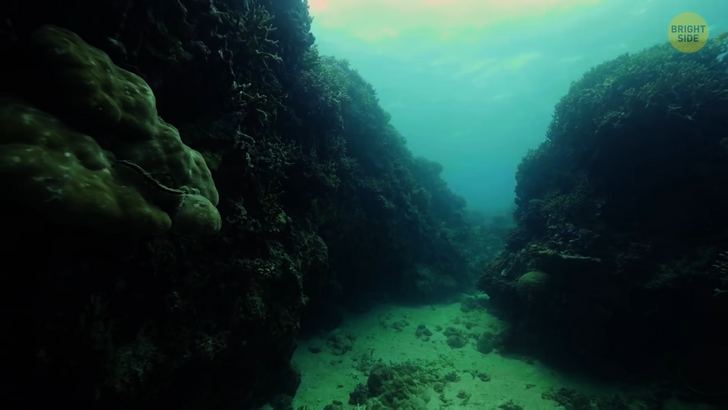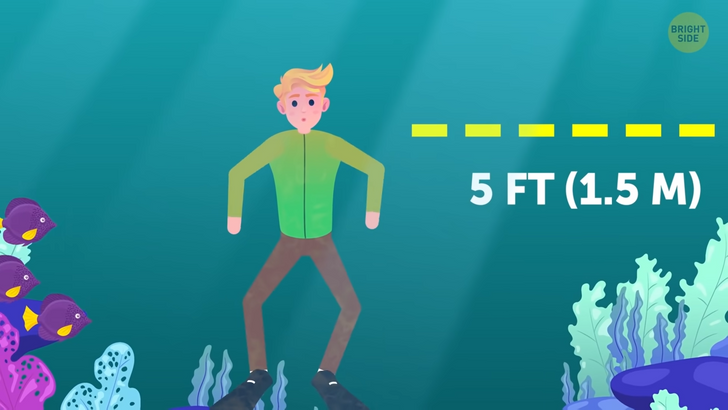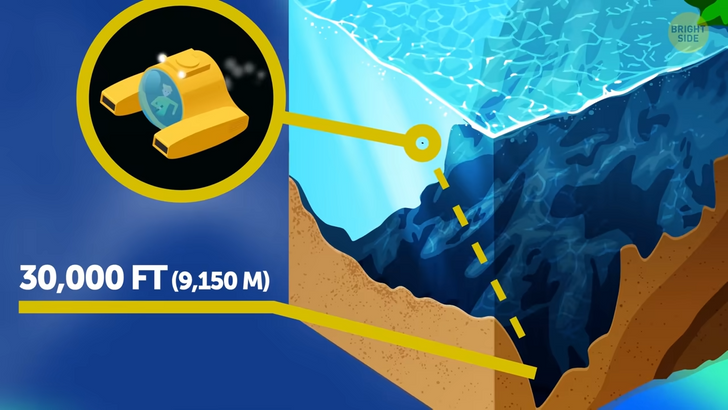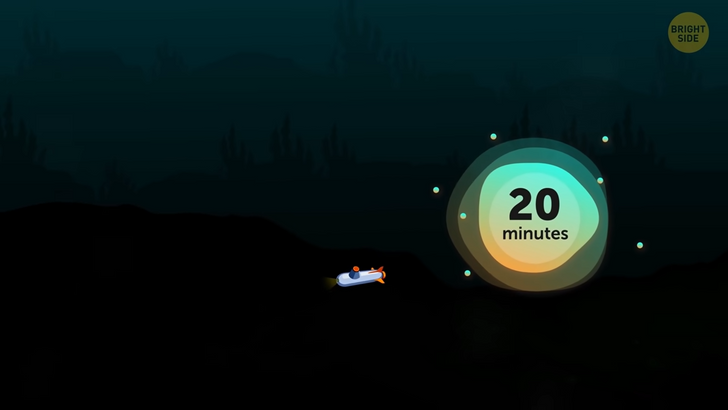so cool
You Can Dive Only 2% of Mariana Trench, Then Trouble Starts

The Mariana Trench in the western Pacific Ocean is the deepest place on our planet. If you throw a rock into the water, it’ll travel 36,000 feet [(11,000 M)] before touching the bottom. But unlike your body, the rock won’t experience any unpleasant consequences.
After all, it doesn’t get affected by all that immense pressure that builds up the deeper you go! But then, what would happen to your body at the very bottom of the Mariana Trench? Put on your flippers, it’s time to dive. Hold your breath!

You’re 5 feet [(1.5M)] below the surface, and it’s still pretty comfortable down there. You’re used to this depth: you go that deep while diving in the pool. Or maybe at the beach, when watching exotic fish swimming near the bottom.
But you’re serious about reaching the deepest point of the Mariana Trench — the Challenger Deep. So, you keep going.
Thirty two feet [32 FT (10 M)] — that’s where you start to feel some discomfort. Here, the pressure pushing down on your body has doubled [x2 pressure]. Your ears and lungs feel a little sore. This is because people have many “air pockets” in their bodies.
And under pressure, these pockets shrink in volume, and you can feel it. But don’t worry. Your organs aren’t made of metal. They’re flexible enough to withstand even more pressure than that. What you SHOULD worry about at this depth is the white shark. If it wants you for dinner, you’re in worse trouble than high pressure. That’s why you’d better keep diving!

Around 65 feet [20 M] underwater. That’s where you’ll need a flashlight and air tanks as you’re running out of breath. The sun’s rays barely reach here, and it’s pretty dark. For the same reason, you’re getting cold. How about putting on a thermal suit, which is what divers usually wear?
Ah, it’s better now. But even though you feel warmer, your ears are starting to hurt — a lot. And your lungs have shrunk almost three times their normal size. This can be risky for an untrained diver.
But you’re brave enough — and now, you’re already at a depth of 100 ft [(30 M)]. Only professional divers go that deep without special equipment! The pressure here is three times higher than what you experience on the surface.
Something weird starts happening to your body. It’s not like anything you’ve ever felt before. And the reason is... your air tank! The compressed air inside is mostly nitrogen (78%) and oxygen (around 21%). But that deep down, nitrogen becomes kinda toxic... It can make you do strange things. Like, you may forget you’re underwater and pull off your oxygen mask.

But if you take tanks with more oxygen in them, the dizziness and other strange sensations will pass. 200 feet [(60 M)] below the surface. The pressure here is 7 times higher than on dry land. Now, even the oxygen becomes unsafe to you. You have to breathe some gas with [oxygen; nitrogen] helium in it.
A sharp drop to a depth of 700 feet [(214 M)]. This mark is the world record in free diving. Herbert Nitsch once managed to reach that deep without any special equipment or air tanks. After that, he received the title of “the deepest man on Earth”. In 2012, he tried to break his own record and plunged to a depth of 830 feet. But it didn’t end well for his health.
Anyway, if you’d trained to hold your breath for that long, you would probably have very few problems now. That deep down, you need to start looking around again because there can be heavy traffic! Submarines travel at this depth, and you sure don’t want to collide with one of them.
A few more feet deeper, and you’ve reached the limits of the average human’s body. At the same time, laboratory experiments have proven that people can withstand even higher pressure.

It went like this: a diver entered a special chamber the size of a room. Scientists simulated high pressure, comparable to a deep dive, inside this chamber. This way, the researchers discovered that a trained person can withstand the pressure similar to that at a depth of 1,600 feet [(500M) depth]!
But the diver couldn’t just walk out of the chamber after the experiment was over. At high pressure, nitrogen, helium, and other gases build up in the body. And if you normalize the pressure at once, those gases form into bubbles. The consequences are extremely unpleasant, to say the least.
So you have to do a gradual ascent from this depth. This way, the gases can leave your body in a natural way [80% gases]. Sometimes a dive takes a few minutes, but coming to the surface stretches for many hours. It’s all about safety!
Okay, now, you have to put on a special suit — otherwise, you won’t be able to dive any deeper. It can protect you at a depth of up to 2,300 feet [(700m)]. The suit’s sealed, and the pressure inside is exactly the same as on the surface.
But all too soon, the suit’s protection isn’t enough anymore. You need a new means to continue your descend. And that’s the Triton 6600 submarine. Now that you’re sitting inside a large iron machine, you feel as if you’re driving a car. Only this “vehicle” is worth $5.5 million. You certainly don’t want to smash it — so, be careful.

You’ve reached a depth of 6,600 feet [(2,010m)]. Don’t even think about getting out of the submarine! The pressure here is 200 times greater than on the surface! Your body just won’t survive this experience.
There’s still almost 30,000 feet [9,150m] to the bottom of the Mariana Trench. If you teleported right there, a huge column of water nearly 7 miles high would press down on you with all its force [7 mi (11km)]. Your sightseeing tour would be over before it began. Even pressurized submarines can’t withstand that kind of force. Large metal machines just bursts like air balloons.
At the moment, people only explore the bottom of the Mariana Trench with the help of robots and drones. One of such machines is Nereus. This is an autonomous underwater vehicle that was built specifically for deep-sea diving. It can withstand pressures 1,000 times greater than those on the surface and reach a depth of nearly 36,000 feet [(11,000 m)].
In May 2009, Nereus got to the bottom of the Challenger Deep — the deepest known point on our planet. Thanks to this machine and its two cameras, people could watch what was going on at that enormous depth.

But people have also set foot in the Challenger Deep. Back in 1960, the Trieste bathyscaphe descended to its bottom. The vessel was carrying two crew members. Unfortunately, they couldn’t see their surroundings well — there was only one small window in the bathyscaphe.
It helped the structure of the ship remain strong. Plus, to withstand the incredible pressure, the iron walls of the bathyscaphe were 5 inches thick [5 in (≈13 cm)].
But when the explorers reached the ocean floor in the Challenger Deep, one of the window’s panes did crack. Luckily, the ship was still able to spend about 20 minutes at the bottom of the ocean and then rise to the surface.
But there are living creatures that are used to such incredible conditions. The Mariana snailfish, for example, lives at a depth of 24,000 feet [(≈7,300m)]!
Even the bottom of the Mariana Trench is inhabited! Bacteria and viruses live there. They’re used to low temperatures and high pressure. And their food is all kinds of organic matter that sinks to the bottom of the ocean.

People can also survive in other extreme conditions — for example, in space. It’s a vacuum. Unlike what many people believe, it’s not cold. It’s also not as dense as air or water. That’s why you’d lose your body heat very slowly.
But you can do an experiment. Normally, water boils at 212˚ F. Let’s say you place a glass of water in a special chamber and gradually lower the pressure. The lower it is, the lower temperature the water needs to boil.
You’re 70% water. And since space is an almost absolute vacuum, the pressure there is extremely low — near zero! And now, think about what can happen with your very liquid blood — I believe you can imagine the consequences.
Also, your internal organs would begin to expand. But that’s not a problem — your tissues are flexible and can withstand such an experience.
The main issue would be the lack of oxygen. Without air, you’d soon lose consciousness. And still, if the rescue team could get to you within 1-2 minutes, you’d be fine.

But there are living organisms that can survive even there. One bacterial species was thriving in outer space near the International Space Station for three years! These bacteria don’t mind the vacuum and a lack of oxygen. They even managed to survive strong solar radiation. They rightfully deserve the title of the world’s most resistant bacteria!
Comments
Related Reads
I Excluded My Wife From My Kids’ Core Memories—She’s Too Busy Working

I Refused to Cancel My Non-Refundable Honeymoon—So My SIL Lied to Punish Me

My MIL Demanded Rent for a House That Isn’t Hers, I Turned the Tables

13 Quiet Acts of Kindness That Turned Ordinary People Into Superhumans

My Daughter Wanted Me to Pay for Her Wedding—I Gave Money to Someone Who Actually Deserved It

I Refuse to Let My Sister Get Away Without Repaying My Money, I’m Not Charity

10 Moments When Kindness Was the Ultimate Power Move

10 Mothers-in-Law Who Know How to Stir the Pot

12 Stories That Had More Drama Than a Season Finale

13 Family Conflicts That Sound Straight Out of a Soap Opera

11 Times People Showed That Real Courage Isn’t Loud—It’s Kind

12 Stories That Prove Little Acts of Kindness Never Stay Little
